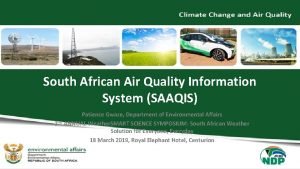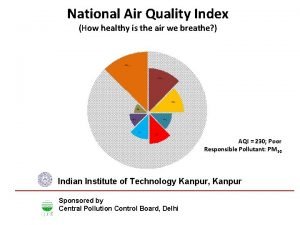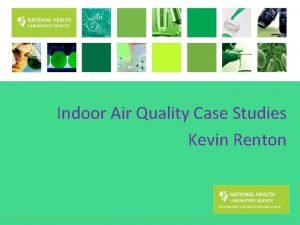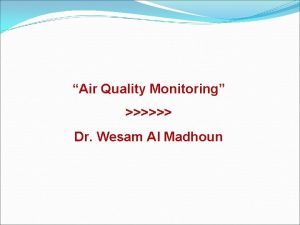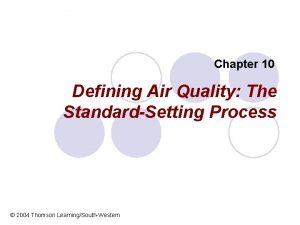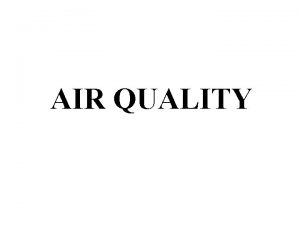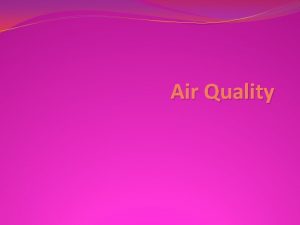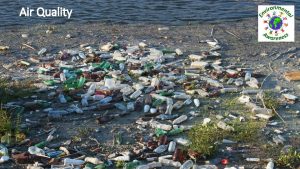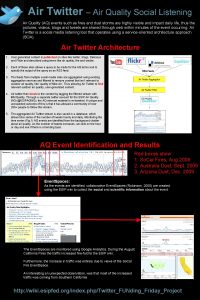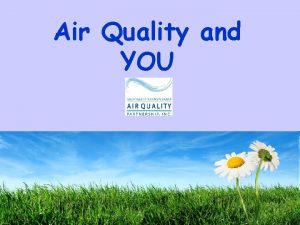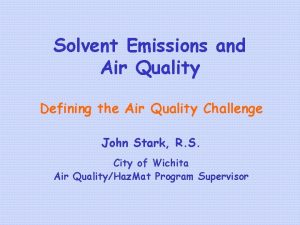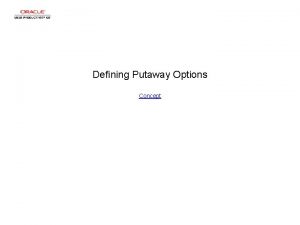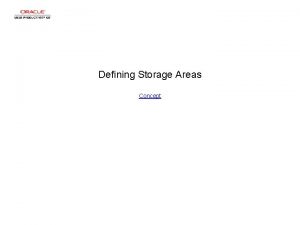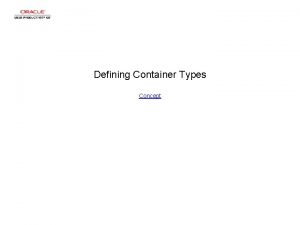Chapter 11 Defining Air Quality The StandardSetting Process





















- Slides: 21

Chapter 11 Defining Air Quality: The Standard-Setting Process © 2007 Thomson Learning/South-Western Thomas and Callan, Environmental Economics

Defining Air Quality n Air quality in the U. S. and other nations is defined through standards that set limits on anthropogenic pollutants n n Anthropogenic pollutants are contaminants associated with human activity Natural pollutants are those that come about through nonartificial processes in nature 2

Overview of U. S. Air Quality Legislation n Early evolution n n There were no national air quality laws until the Air Pollution Control Act of 1955 There was no truly comprehensive legislation until Clean Air Act of 1963 3

Overview of U. S. Air Quality Legislation n Current U. S. Policy n 1990 Clean Air Act (CAA) Amendments use some market-based approaches, but the underlying structure continues to be command-control oriented 4

Identifying Major Air Pollutants n Criteria pollutants are substances known to be hazardous to health and welfare, characterized as harmful by criteria documents n Hazardous air pollutants are noncriteria pollutants that may cause or contribute to irreversible illness or increased mortality 5

Setting Standards to Define Air Quality n EPA sets national standards for the major air pollutants to be met by potentially controllable sources n n Stationary sources are fixed-site producers of pollution, such as a building or manufacturing plant Mobile sources are any nonstationary polluting sources, including all transport vehicles 6

Standards for Criteria Air Pollutants n National Ambient Air Quality Standards (NAAQS) set maximum allowable concentrations of criteria air pollutants n n Primary NAAQS are set to protect public health from air pollution, with some margin of safety Secondary NAAQS are set to protect public welfare from any adverse, nonhealth effects of air pollution 7

6 Criteria Air Pollutants n particulate matter (PM-10 and PM-2. 5) n sulfur dioxide (SO 2) n carbon monoxide (CO) n nitrogen dioxide (NO 2) n tropospheric ozone (O 3) n lead (Pb) 8

Standards for Hazardous Air Pollutants n National Emission Standards for Hazardous Air Pollutants (NESHAP) are set to protect public health and the environment and are applicable to every major source of any identified hazardous air pollutant n Maximum Achievable Control Technology (MACT) is the technology that achieves the reduction to be accomplished by the NESHAP 9

Infrastructure To Implement the Standards Two Key Elements n State Implementation Plan (SIP) n An EPA-approved procedure outlining how a state intends to implement, monitor, and enforce the NAAQS and the NESHAP n Air Quality Control Region (AQCR) n A federally-designated geographic area within which common air pollution problems are shared by several communities 10

Reclassification of AQCRs n In 1974, following a suit filed by the Sierra Club, AQCRs were reassessed to identify 3 types of regions: n n n Regions that met or exceeded the standards as Prevention of Significant Deterioration (PSD) areas Regions not in compliance with the standards as nonattainment areas Regions with insufficient data n In 1990, the new CAA Amendments reclassified all nonattainment areas into new categories that identified the severity of the pollution 11

Monitoring Air Quality Across Regions n Estimating pollutant emissions levels n Best available engineering methods are used to derive annual emissions estimates for over 450 source categories n Measuring pollutant concentrations n Pollutant concentration levels are measured at air-monitoring station sites located throughout the country p Most of these sites are in urban regions p Reported to the EPA via an air-monitoring network 12

Analysis of U. S. Air Quality Policy Evaluation Criteria n Equity criterion n Environmental justice p In 1993, environmental justice became one of the EPA’s seven guiding principles n Economic criterion n Allocative efficiency p Arises where marginal social costs (MSC) and marginal social benefits (MSB) are equal 13

Portney’s Benefit-Cost Analysis of 1990 Policy n Offers a point estimate for MSB of $14 billion and a point estimate for MSC of $32 billion annually n Since MSC far outweighs MSB, it might be that Titles II through V of the 1990 Amendments overregulate society 14

Graphing Portney’s Findings $1990 billions MSC 32 Inefficiency 14 MSB 0 AE A 1990 Abatement 15

EPA’s Benefit-Cost Analysis of 1990 Policy n In its final report to Congress, the EPA estimates that the present value of net benefits associated with Titles I through V of the 1990 CAAA for the 1990 to 2010 period is $510 billion ($1990) n EPA’s quantitative results, though recognized as based on sound methods and data, are considered to be controversial on a number of fronts n Discussed in Freeman (2002) and Krupnick and Morgenstern (2002) 16

Analysis of NAAQS Two Potential Sources of Inefficiency n No cost considerations in standard-setting n Uniformity of the standards 17

Absence of Cost Considerations n NAAQS are solely benefit-based n Economic feasibility not explicitly considered n Primary standards include “margin of safety” 18

Uniformity of NAAQS n NAAQS are nationally based, ignoring regional cost or benefit differences n e. g. different pollution levels, access to technology, demographics, etc. n Exception is that distinctions are allowed for PSD areas n PSD areas face higher standards than NAAQS n Are higher standards for PSDs efficient? p Only if MSCPSD = MSBPSD at a higher A level p Let’s examine possible scenarios that support such an outcome 19

Scenarios Achieving Efficiency $ MSCNON (a) MSCPSD = MSCNON $ MSCPSD (b) MSBPSD = MSBNON APSD $ MSBNON A ANON MSCNON APSD A MSCPSD Which of these are feasible? (c) MSBNON MSBPSD ANON APSD A 20

Feasibility n Panels (a) and (b) are not likely. Why? n MSBNON likely higher than MSBPSD n MSCNON likely higher than MSCPSD n Panel (c) is possible only under a series of conditions n Suggests that higher standards in PSD areas may be justifiable on efficiency grounds but only under certain economic conditions. 21
 Example of non defining relative clause
Example of non defining relative clause Relative clauses defining and non defining
Relative clauses defining and non defining Relative clauses defining and non defining
Relative clauses defining and non defining Defining relative clause meaning in telugu
Defining relative clause meaning in telugu Rel clause
Rel clause Defining and non-defining relative clause
Defining and non-defining relative clause Hubungan air tanah dan tanaman
Hubungan air tanah dan tanaman Chapter 12 section 1 what causes air pollution answers
Chapter 12 section 1 what causes air pollution answers Chapter 12 air section 1 what causes air pollution
Chapter 12 air section 1 what causes air pollution Quality assurance vs quality control
Quality assurance vs quality control Project quality management pmp
Project quality management pmp Pmbok quality assurance vs quality control
Pmbok quality assurance vs quality control Quality assurance cycle in nursing
Quality assurance cycle in nursing Quality improvement vs quality assurance
Quality improvement vs quality assurance Qa basic concepts
Qa basic concepts David a garvin 8 dimensions of quality
David a garvin 8 dimensions of quality Crosby's fourteen steps to quality improvement
Crosby's fourteen steps to quality improvement Old quality vs new quality
Old quality vs new quality Saaqis
Saaqis Air quality index calculation
Air quality index calculation Air quality renton
Air quality renton Ambient air quality standards
Ambient air quality standards


















